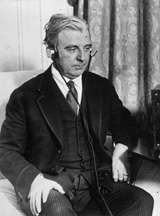Cameron A. Morrison
Cameron A. Morrison (October 5, 1869 – August 20, 1953) was the 55th Governor of the U.S. state of North Carolina from 1921 to 1925.
Cameron A. Morrison | |
|---|---|
 | |
| Member of the U.S. House of Representatives from North Carolina's 10th district | |
| In office January 3, 1943 – January 3, 1945 | |
| Preceded by | New Constituency (Redistricting) |
| Succeeded by | Joseph W. Ervin |
| United States senator from North Carolina | |
| In office December 13, 1930 – December 4, 1932 | |
| Preceded by | Lee S. Overman |
| Succeeded by | Robert R. Reynolds |
| 55th Governor of North Carolina | |
| In office January 12, 1921 – January 14, 1925 | |
| Lieutenant | William B. Cooper |
| Preceded by | Thomas Walter Bickett |
| Succeeded by | Angus Wilton McLean |
| Personal details | |
| Born | October 5, 1869 Rockingham, North Carolina, U.S. |
| Died | August 20, 1953 (aged 83) Quebec City, Quebec, Canada |
| Political party | Democratic |
Early life and career
He was born in 1869 in Richmond County, North Carolina.
In 1898, Morrison participated in the Wilmington insurrection of 1898, a violent coup d'état by a group of white supremacists. They expelled opposition black and white political leaders from the city, destroyed the property and businesses of black citizens built up since the Civil War, including the only black newspaper in the city, and killed an estimated 60 to more than 300 people. [1] In 1900, he was elected to the North Carolina Senate for one term.[2]
Governorship
With the backing of Sen. Furnifold Simmons and the help of race-baiting tactics employed by A. D. Watts, Morrison defeated O. Max Gardner in the 1920 Democratic primary for governor.[3] In the general election, he defeated Republican nominee John J. Parker.
He came to be called "the Good Roads governor" for his support of a modern highway system. Morrison also pushed for increased funds for public education, while also battling the teaching of the theory of evolution.[4]
Later career
He was later appointed to serve as a United States Senator for the state of North Carolina (after the death of Lee S. Overman) between 1930 and 1932, but lost his seat in the Democratic primary runoff to Robert R. Reynolds.[5]
Morrison was later elected to one term in the United States House of Representatives from 1943 to 1945.[6] He again lost a Democratic primary for a U.S. Senate seat in 1944, to Clyde R. Hoey.[7] He died in Quebec City in 1953. A ten-story residence hall on the campus of UNC-Chapel Hill is named in his honor.
His home at Charlotte, Morrocroft, was listed on the National Register of Historic Places in 1983.[8]
References
- "RACE QUESTION IN POLITICS:North Carolina White Men Seek to Wrest Control from the Negroes". New York Times. October 24, 1898.
- NCpedia biography of Cameron Morrison
- News & Observer: "What the obituary didn't say" by Rob Christensen Archived 2008-07-18 at the Wayback Machine
- "Evolution Controversy in NC in the 1920s". unc.edu. Archived from the original on 20 February 2009. Retrieved 15 April 2015.
- "Our Campaigns - NC US Senate - D Runoff Race - Jul 02, 1932". ourcampaigns.com. Retrieved 15 April 2015.
- "Our Campaigns - NC District 10 Race - Nov 03, 1942". ourcampaigns.com. Retrieved 15 April 2015.
- "Our Campaigns - NC US Senate - D Primary Race - May 27, 1944". ourcampaigns.com. Retrieved 15 April 2015.
- "National Register Information System". National Register of Historic Places. National Park Service. July 9, 2010.
External links
- United States Congress. "Cameron A. Morrison (id: M000993)". Biographical Directory of the United States Congress.
- Cameron A. Morrison at the North Carolina History Project
| Party political offices | ||
|---|---|---|
| Preceded by Thomas Walter Bickett |
Democratic nominee for Governor of North Carolina 1920 |
Succeeded by Angus Wilton McLean |
| Political offices | ||
| Preceded by Thomas Walter Bickett |
Governor of North Carolina 1921–1925 |
Succeeded by Angus Wilton McLean |
| U.S. Senate | ||
| Preceded by Lee Slater Overman |
U.S. senator (Class 3) from North Carolina 1930–1932 Served alongside: Furnifold McLendel Simmons, Josiah William Bailey |
Succeeded by Robert Rice Reynolds |
| U.S. House of Representatives | ||
| Preceded by Alfred L. Bulwinkle |
Member of the U.S. House of Representatives from North Carolina's 10th congressional district 1943–1945 |
Succeeded by Joseph Wilson Ervin |

